
Ah, link building. The bread and butter of SEO. It may be a surprise if you don’t work in the industry but the answer to a website’s organic success often lies in those seemingly innocuous little hyperlinks scattered across the web.
But here’s the kicker—link building isn’t just about collecting as many links as possible and hoping for the best. It’s an art, a science, and occasionally, a bit of a gamble. Do it right, and you’re golden. Do it wrong, and your website could end up in Google’s bad books faster than you can say “algorithm update.”
Now, let’s talk about doing it right. Enter white hat link building, the knight in shining armour of the SEO world. Unlike its shadier counterparts—black hat and grey hat link building—white hat techniques are all about staying on Google’s good side while still driving those all-important clicks to your site. It’s ethical, it’s effective, and most importantly, it won’t get you penalised.
But before we delve into the nitty-gritty of white hat strategies, let’s first get a grip on the basics of link building and why it’s so crucial for SEO.
What is White Hat Link Building?
White hat link building—sounds fancy, doesn’t it? But in reality, it’s as straightforward as it gets in the world of SEO. At its core, white hat link building is about playing by the rules. It involves creating high-quality content, building genuine relationships, and earning links organically, rather than trying to trick or manipulate search engines.
Think of it as the ethical route to climbing the search rankings. While black hat link building is like cutting corners in a marathon (sure, you might get ahead for a bit, but you’ll likely get disqualified), white hat techniques ensure you reach the finish line fair and square—and with your reputation intact.
The beauty of white hat link building lies in its long-term benefits. Rather than chasing quick wins, you’re building a foundation that will stand the test of time. The links you earn are from reputable sources, which means they’re more likely to boost your authority and keep you in Google’s good graces.

White Hat vs. Grey Hat vs. Black Hat Link Building
| Type | Definition | Core Principles/Techniques | Risks & Consequences |
| White Hat | Ethical link building practices that adhere to search engine guidelines. | Focus on quality, relevance, and ethical practices. Links are earned organically. | Minimal risk. Long-term benefits with sustainable SEO. |
| Grey Hat | Techniques that blur the line between ethical (white hat) and manipulative (black hat) practices. | May involve strategies that are not explicitly against the rules but push boundaries. | Moderate risk. Potential for penalties if tactics are detected by search engines. |
| Black Hat | Manipulative practices designed to game search engine rankings. | Includes tactics like link farming, buying links, and using automated tools. | High risk. Severe penalties, including being banned from search results, and long-term damage to SEO. |
Importance of White Hat Link Building
Why should you bother with white hat link building? Why not just take the shortcut and rack up those links any way you can? Well, here’s the thing: in the world of SEO, shortcuts are often more trouble than they’re worth.
White hat techniques are crucial for sustainable SEO. They’re not just about avoiding penalties—though that’s certainly a big part of it—but about building a strategy that’s resilient and future-proof. Google’s algorithms are always evolving, and what might seem like a clever trick today could land you in hot water tomorrow. White hat practices ensure that your site’s SEO is built on a solid, ethical foundation, one that’s less likely to crumble under the pressure of an algorithm update.
On the flip side, black hat techniques might get you some quick wins, but they come with serious risks. Google’s penalties for manipulative tactics can be severe, from dropping your site’s ranking to removing it from search results altogether. Grey hat strategies, which teeter on the edge of what’s acceptable, aren’t much better—they’re a gamble, and the house (i.e., Google) usually wins.
In contrast, white hat link building is a safe bet. It might take longer to see results, but when those results come, they’re more likely to stick. Plus, you’ll sleep better at night knowing you’re playing by the rules.
Master White Hat Link Building: 10 Techniques for Ethical SEO
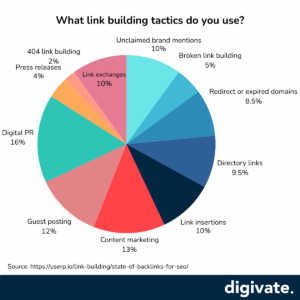
1. Guest Blogging
Start by researching blogs that have a strong following in your industry. Use tools like Ahrefs or SEMrush to identify blogs with good domain authority and an engaged audience. Alternatively, you can even ask ChatGPT for a list of blogs in your niche that allow guest posts – just remember to double-check the results as sometimes they can be wrong. You want to look for blogs that regularly feature guest posts and cover topics relevant to your expertise.
When crafting a guest post, focus on providing actionable insights and practical tips. Write content that addresses common pain points in your industry. Use data, case studies, or personal experience to back up your claims. Incorporate internal links to other relevant articles on the host blog and subtly include a link back to your site in the author bio or within the content where it feels natural. Remember, the more value you provide, the more likely readers are to share and link back to your post.
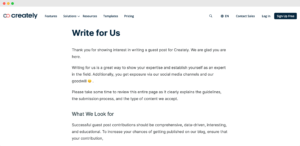
2. Resource Link Building
Identify top-tier resource pages within your niche by searching for keywords like “best resources for [your industry].” Analyse these pages to understand what kind of content they feature. Then, create an outstanding resource that fills a gap or updates outdated information. Make sure your content is comprehensive, well-researched, and visually appealing.
Reach out to the webmasters of the resource pages you identified. In your outreach email, explain why your content would be a valuable addition to their list. Highlight how your resource complements existing content and benefits their audience. Be polite, concise, and persistent—follow up if you don’t receive a response after a week or two.
3. Broken Link Building
Use tools like Check My Links or Ahrefs to identify broken links on websites within your niche. Focus on sites with high domain authority and content related to your industry. Broken links represent an opportunity to offer a solution with your content.
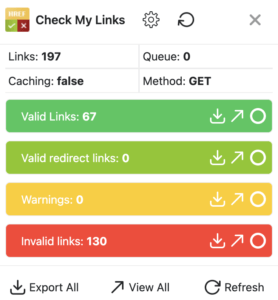
Once you’ve identified a broken link, create or repurpose content that matches what the original link was supposed to provide. Reach out to the website owner, letting them know about the broken link and suggesting your content as a replacement. Be sure to highlight how your content is relevant and beneficial for their audience. Personalise your outreach to increase the chances of a positive response.
4. Content Partnerships
Identify influencers or businesses in your industry whose audiences would benefit from your expertise. Reach out to propose a content partnership, whether it’s co-authoring a blog post, creating a joint webinar, or producing a video series. Ensure that both parties bring value to the table and that the content will be mutually beneficial.
When working together, focus on producing content that is unique, insightful, and actionable. Promote the co-created content across both of your platforms to maximise reach. The collaboration not only provides valuable backlinks but also exposes your brand to a broader audience, increasing your credibility and authority.
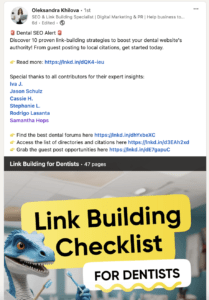
5. Skyscraper Technique
Use tools like BuzzSumo or Ahrefs to find content in your industry that has garnered a lot of backlinks. Analyse this content to understand why it performed well—look at factors like length, depth, media usage, and topic relevance.
Once you’ve identified the top content, create an even better version. This could mean updating the information, adding more in-depth analysis, including visual elements like infographics, or offering additional resources. After publishing your content, reach out to websites that linked to the original piece, letting them know about your improved version and suggesting they link to it instead.
6. Leveraging Social Proof and Testimonials
Actively request reviews and testimonials from satisfied customers. Encourage them to share their experiences on your website and other platforms like Google My Business or industry-specific review sites. Display these testimonials prominently on your site to build trust and authority.
Once you have a solid collection of testimonials, use them in your content, especially in case studies or success stories. Reach out to industry blogs or influencers to share these stories. The authenticity and trust that come with social proof can lead to natural backlinks from sites looking to share credible, real-world experiences.
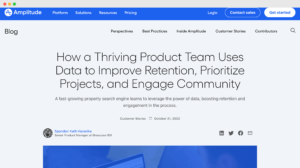
7. Unclaimed Brand Mentions
Unclaimed brand mentions are instances where your brand is mentioned online, but without a backlink to your website. This is a golden opportunity to turn those mentions into valuable backlinks.
- Monitor brand mentions: Use tools like Google Alerts, Mention, or BuzzSumo to track mentions of your brand across the web.
- Search manually: Perform a search for your brand name or product names in quotation marks to find mentions on forums, news sites, and blogs.
- Reach out: Contact the webmaster, journalist, or blogger who mentioned your brand. Politely request that they add a link to your website.
- Provide context: Explain why linking to your site provides additional value for their readers. Highlight any relevant content or resources they might be missing out on.
- Follow up: If you don’t get a response, follow up with a gentle reminder. Persistence often pays off.
8. Utilising Local Directories and Citations
List your business on local directories like Yelp, Google My Business, and industry-specific platforms. Ensure you choose directories with good domain authority to gain the most SEO benefits, but also pick directories that your potential customers may use.

Consistency is key when it comes to NAP (name, address, phone number) details. Double-check that your business name, address, and phone number are identical across all directories and your website. This consistency not only boosts your local SEO but also ensures customers can easily find and contact you, further enhancing your credibility and linkability.
9. Conduct research that leads to usable industry statistics
Using statistics to build backlinks is one of the most effective ways to attract natural links from reputable sites. Think about it—people love data! When you create content filled with original, relevant statistics, you’re offering something others will want to reference. Start by conducting a survey, compiling industry reports, or analysing trends within your niche.
Publish these findings in an easy-to-digest format like infographics, charts, or detailed reports. Once your data-driven content is live, reach out to industry blogs, journalists, or websites that cover similar topics. Let them know your stats are available for reference (with a nice backlink, of course).
Pro tip: If you don’t have the resources to do research and create your own data you can always combine the data other people have done into one mega statistics article that could be the go-to resource for your readers – think “The top 500 most useful statistics about ecommerce”.
10. Create link-worthy content
Creating link-worthy content is one of the most powerful white hat link-building strategies, and it all starts with writing long-form, in-depth articles that provide real value. Studies show that long-form content gets an average of 77.2% more links than shorter pieces, and it’s not just about length—it’s about substance.
When you write comprehensive, insightful pieces on a topic, you’re creating a resource that journalists, bloggers, and industry experts will want to reference and link to.
The goal here is to develop content that answers all the questions someone might have about a particular subject, making it the ultimate go-to resource. Think “ultimate guides,” “how-to articles,” “exclusive research,” or “detailed list posts.” Aim for 3,000 words or more, covering every angle of the topic—not just the basics. For instance, if you’re writing about coffee, dive into subtopics like the different types of beans, brewing methods, coffee roasts, and the science behind the perfect cup.
The more comprehensive, the better your chances of earning backlinks.
But don’t stop there—consider adding infographics to your content mix. Infographics are highly shareable and visually appealing, making complex information easier to understand. In fact, 53% of marketers use infographics as part of their white hat link-building strategy. They’re a great way to summarise data, break down complex concepts, or visually showcase statistics in a digestible format. Create an infographic that complements your content, and you’ll not only enhance its value but also open the door to even more backlinks.
The Importance of Ethical SEO Practices
-
Long-term benefits of white hat techniques
- Builds authority and trust: Ethical practices help establish your site as a credible source, earning trust from both search engines and users.
- Sustainable traffic: White hat techniques lead to lasting rankings and consistent traffic, rather than short-term gains.
- Avoiding penalties and negative consequences
- Penalties for grey/black hat techniques: Engaging in questionable practices can result in search engine penalties, which may severely damage your site’s visibility.
- High cost of recovery: Recovering from penalties isn’t just time-consuming—it’s costly. The resources spent on fixing a tarnished reputation often outweigh any short-term gains from unethical practices.
- Aligning SEO with business integrity
- Positive brand reflection: Ethical SEO practices demonstrate your commitment to honesty, enhancing your brand’s reputation.
- Loyal customer base: Customers value transparency and trustworthiness, leading to increased loyalty and long-term customer relationships.
Conclusion
In the competitive landscape of SEO, the temptation to cut corners with grey or black hat techniques can be strong. However, these shortcuts often lead to penalties, lost trust, and long-term damage to your online presence.
Imagine spending months or even years building your brand’s authority, only to have it all come crashing down due to unethical practices. The cost of recovering from a search engine penalty is steep—not just financially but also in terms of lost time and credibility. The risks associated with non-ethical SEO aren’t worth the temporary gains.
By focusing on white hat link building techniques, you can achieve sustainable success that benefits your brand in the long run. From guest blogging to leveraging social proof, each method discussed empowers you to build high-quality, ethical backlinks that search engines love.
Contact us today to discuss how our link building and SEO services can help you achieve your goals. Explore our services and see how we can support your journey toward ethical SEO success.



